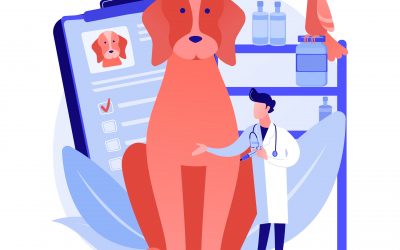Demystifying The Pet Insurance Landscape

Originally featured in the March 5, 2024 edition of The Woof.
Introduction
Pet insurance covers veterinary expenses related to the health and well-being of pets, primarily cats and dogs. The overall market has seen substantial growth over the past several years as more and more pet owners recognize the importance of quality healthcare for their pets. Pet insurance provides peace of mind to pet owners by providing financial protection against unexpected veterinary expenses. With the cost of veterinary care rising across the United States, it sometimes becomes unaffordable for pet parents to consider and pay for the recommended course of treatment from their vet. Having a pet insurance policy in place often removes this burden by reimbursing for eligible expenses, with the primary exclusion being pre-existing conditions diagnosed before the insurance policy’s effective date. Insurance allows owners to focus their energy on their pet and recovery rather than worry about the treatment and the cost.
Current Landscape
Today, the pet insurance market is on the rise, growing almost 22% from 2021 to 2022, or 4.4 million to 5.36 million pets insured (https://naphia.org/industry-data/). However, it is still relatively small compared to the number of pets in households in the United States, international markets, and other specialty insurance lines.
The increase in pet ownership has contributed to the expansion of the pet insurance market, though less than 3% of pets are protected. According to a recent article in Forbes, 66% of US households own a pet, equating to 86.9 million homes. Most insured pets are dogs, representing 80.1%, and cats represent 19.9%, per the most recent NAPHIA study.
Evolution of the Pet Insurance Industry
The pet insurance industry has become more mainstream as pet ownership has increased, and the humanization of pets has become more prominent. Some of the bigger companies in the pet insurance space, such as Trupanion, Embrace, Figo, Nationwide, and Spot, as well as newer ones like Pumpkin and Odie, have contributed to this evolution.
While early pet insurance policies typically covered only accidents and injuries, newer plans, like Odie, have expanded to include additional benefits such as coverage for exam fees, acupuncture, rehab, chiropractic care, and prescription medication reimbursements. With this flexibility, pet owners can choose a plan that aligns with their pet’s specific healthcare needs.
Technology has also transformed the pet insurance industry for pet owners, insurers, and veterinary providers through the digitization of pet insurance purchases, claims, reimbursements, and overall management. Pet parents can quickly research, compare, and purchase pet insurance plans with immediate delivery of their policy documents.
Digital pet insurance platforms and mobile-optimized experiences make it easy for pet parents to manage their policies. Through online member portals, policyholders can view documents, submit claims, and track the status of their reimbursements. Digital processing has also shortened the time between when a policyholder pays their bill at the vet and reimbursement, reducing financial strain.
Additionally, electronic veterinary medical records have helped make pet insurance easier to use and more integrated into veterinary practices and care.

Pet Insurance Models
Reimbursement
Most key players in the pet insurance space operate on a reimbursement model. Policyholders pay upfront for veterinary bills and submit their invoices and medical reports after payment has occurred. The invoice is then reviewed by the insurance company, and a check or digital payment is sent to the policyholder for the covered amount.
Direct Pay
Some pet insurance companies offer to pay a policyholder’s vet expenses directly. This model may require the veterinarian’s office to use specific software that directly communicates with the insurance company.
Specialized Credit
Alternative financing options include specialized lines of credit or credit cards that can be used at the vet’s office. This option allows bills to be paid in small installments, which can be helpful to cover large, unexpected bills.
Wellness Plan Models
Wellness Plans provide reimbursement for routine care items such as vaccinations, heartworm prevention, and flea and tick medication. Wellness plans are not insurance policies, but they help provide financial relief for items pet parents are likely purchasing to maintain the health and wellness of their pets.
Per-Item Limited Reimbursement
The industry’s most common wellness plan model reimburses for preventative care items up to a pre-defined amount. This amount may not always cover the entire cost of the service, but this model offers coverage for a wide range of items, so policyholders are more likely to use the plan and maximize the value received.
Per-Item Full Reimbursement
This model reimburses the total amount for services specified at a given frequency per year (i.e., one routine wellness exam, two vaccines). Due to the variability in costs incurred by insurance companies, these plans tend to cover fewer routine care items than per-item limited reimbursement plans and may be more expensive.
Per Category Spend Allowance
The Per Category Spend Allowance model has more significant limits on broad categories such as Exams and Vaccines, Testing, Dental, and others. However, fewer expenses may be covered under this plan.
Annual Limit Spend Allowance
In this veterinary care financing model, a monthly payment entitles the policyholder to a set annual “budget” for wellness care. The total funds are immediately available upon enrollment, which is useful when there is an immediate need for preventative veterinary expenses, such as a dog spaying procedure.
Strategies Used by Key Players – Limits and Deductibles
Annual deductible vs. Per-Incident Deductible
Pet insurance plans usually include an annual deductible, the yearly cost the policyholder will pay before the pet insurance begins to reimburse for eligible expenses. Some, however, offer “per-incident” deductibles, in which policyholders pay a set amount for each new health issue or vet visit.
Illness/Line-item limits
Pet insurance providers sometimes have coverage limits for specific illnesses or conditions, regardless of the overall maximum annual limit for the plan. For instance, if your pet is diagnosed with cancer and the plan has a cancer limit of $5,000 per year, you will only be reimbursed up to $5,000 for those expenses, even if the treatment costs more, and the maximum annual spend for the plan is $10,000.
Unlimited Plans
Unlimited annual limits are sometimes highlighted with pet insurance plans. These policies typically have higher premiums, and in many cases, the pet owner will not reach the maximum payout limit in any given year.
“Healthy Pet” discounts
Healthy pet discounts reward pet owners who have not filed any claims during a specified period and whose pets have maintained good health. These discounts incentivize responsible pet care and can result in significant cost savings by encouraging preventive measures such as regular veterinary check-ups, vaccinations, and a healthy lifestyle.
Special Benefits
Many companies in the pet insurance space differentiate themselves through their unique benefits and perks. Examples include training for medically diagnosed behavioral issues, dental care, prescription foods, free televet access, end-of-life expenses (including cremation or burial costs), and alternative therapies like stem-cell and supplements.
The Future of Pet Insurance
The humanization of cats, dogs, and other pets has led to the enhanced popularity of pet insurance, as many pet owners today prioritize quality care and preventative care for their pets. This will continue to be a trend as pet insurance companies and related pet health brands emphasize education and awareness efforts around routine care and better-for-your-pet products.
As treatment costs increase due to inflation, new/more treatment options become available, the shortage of veterinary professionals, and as the demand for healthcare services continues to increase, pet parents will continue to seek financial protection through comprehensive and inclusive coverage. Affordability of care and flexible access, including benefits such as 24/7 telehealth access, will be increasingly popular in the pet insurance space.
The introduction of AI has already helped advance and automate processes. As AI continues to be able to process and analyze important documents like medical records, it will help pet insurers better price risk, create policies that are more beneficial for insureds, and better understand the needs of pets.
Are you interested in pet insurance for your cat or dog? Odie offers an Illness and injury Plan and an Accident-Only Plan, plus a Wellness Plan add-on for routine care reimbursements. Learn more at GetOdie.com.


